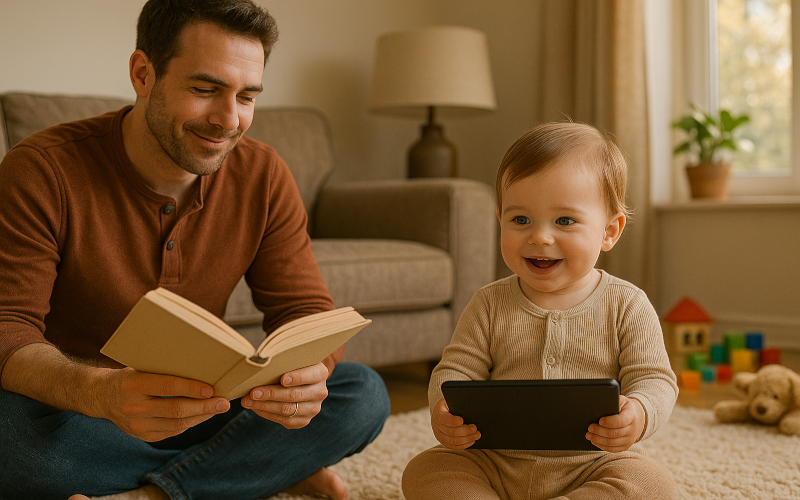
Screen Time and Toddlers: How Much Is Too Much?
The iPad Babysitter Dilemma
Hand a toddler an iPad, and suddenly you’ve bought yourself thirty blissful minutes to drink coffee while it’s still warm. Hand that same iPad back an hour later, and you may be dealing with a full-volume meltdown.
Sound familiar? You’re not alone. Parents everywhere wrestle with how much screen time is “okay.” In this guide, we’ll cut through the noise and help you set boundaries that work for your family without guilt.
What the Experts Actually Say
Let’s start with some science-backed recommendations.
-
The American Academy of Pediatrics (AAP)suggests no screen time for children under 18 months (except for video chatting with family).
-
For toddlers 18 to 24 months, high-quality, interactive content is okay but always with a caregiver alongside.
-
For children ages 2 to 5, limit screen time toabout one hour per dayof high-quality programming.
The AAP screen time guidance notes that context matters: educational content and co-viewing are very different from endless YouTube autoplay.
And according to the CDC, heavy screen use at young ages can affect sleep, attention, and social skills.
The Good, the Bad, and the Meltdown-Inducing
Not all screen time is created equal.
The Good:
-
Educational apps that teach colors, numbers, or letters.
-
Video calls with grandparents (family bonding = 💛).
-
Music and dance videos that get kids moving.
The Bad:
-
Fast-paced cartoons with endless ads.
-
Passive viewing for hours without interaction.
-
Screens at bedtime (blue light disrupts sleep).
The Meltdown-Inducing:
-
Sudden removal of screens without warning.
-
“Just one more episode” battles.
-
Kids becoming dependent on screens to self-soothe.
“Screen time for toddlers isn’t the enemy, it’s about quality, balance, and boundaries.”
Practical Parent Strategies for Balance
So how do you actually do this without losing your sanity?
1. Set Routines
-
Make mealtimes screen-free zones.
-
Establish a “no screens one hour before bed”rule.
-
Keep screen use at consistent times of day (like a set 30 minutes after nap).
2. Co-View Whenever Possible
-
Narrate what’s happening (“That’s a red car! What color is your toy car?”).
-
Ask questions and engage, so it becomes interactive learning.
3. Use Built-In Tools
-
Many tablets and smart TVs haveparental controlsor built-in timers.
-
External tools like a screen-time timer device can automatically limit use.
4. Swap Screens for Activities
-
Coloring books, puzzles, or Montessori blocks.
-
Outdoor time, even a quick backyard adventure.
-
Music and dancing for movement.
The Mayo Clinic reinforces that balance and parental modeling are crucial: if we’re always on our phones, kids notice.
Affiliate-Friendly Tools and Alternatives
Parents don’t need more stress, they need tools that help. Here are some smart picks:
-
Blue-light filtering glasses for kids: protect young eyes from extended tablet use → Shop kids’ blue light glasses.
-
Child-safe headphones: volume-limited headphones prevent ear damage → Browse toddler-safe headphones.
-
Screen-time timer devices: turn off Wi-Fi or apps after set limits → See screen-time timers.
-
Non-screen swaps: puzzles, STEM kits, or art sets for toddlers.
Parental Tip
👉 Try a “2-for-1 swap” rule: for every 30 minutes of screen time, plan one hour of non-screen activity. This keeps balance without battles.
Screen time for toddlers doesn’t have to be scary, and you don’t have to feel guilty. It’s about balance, structure, and intentional use. Stick to expert guidelines, set clear boundaries, and lean on helpful tools to keep screens a support, not a struggle.
Your toddler can thrive in a digital age without becoming glued to a screen.
Author Bio
Earnest Sherrillis a writer, parent, and family advocate who blends humor with research to make modern parenting a little easier. Through LittleLloyds.com and the mTDLN Newsletter, he helps parents find balance in a digital world. When he’s not writing, you’ll find him sipping cold coffee while pretending Paw Patrol isn’t on its 900th replay.
